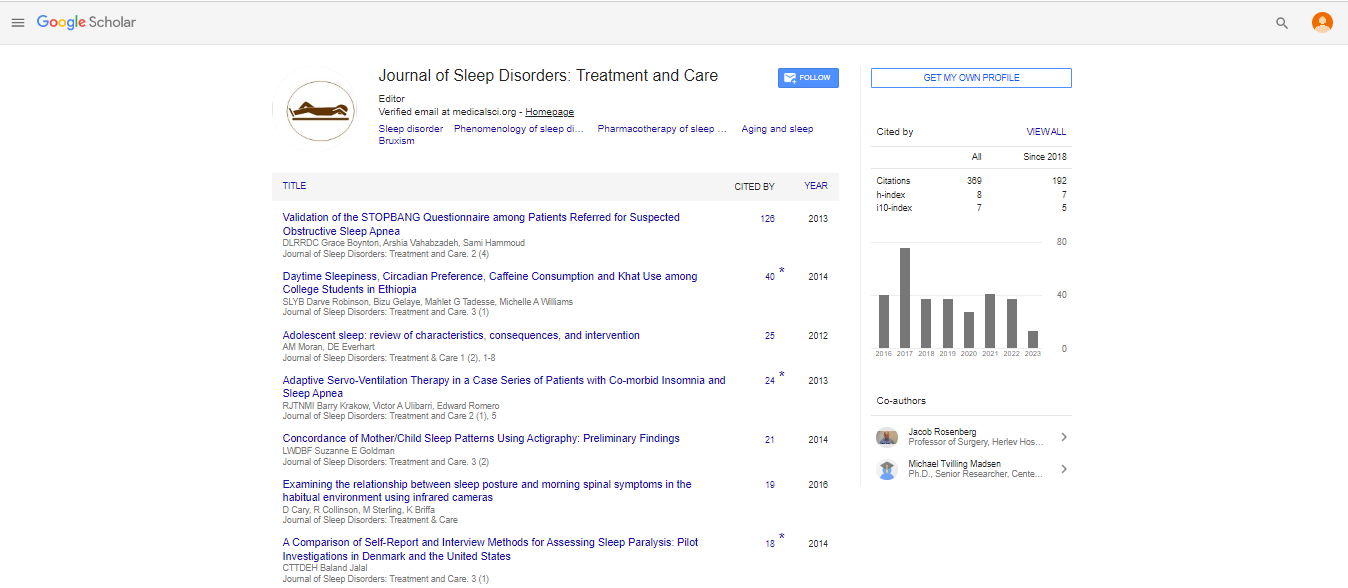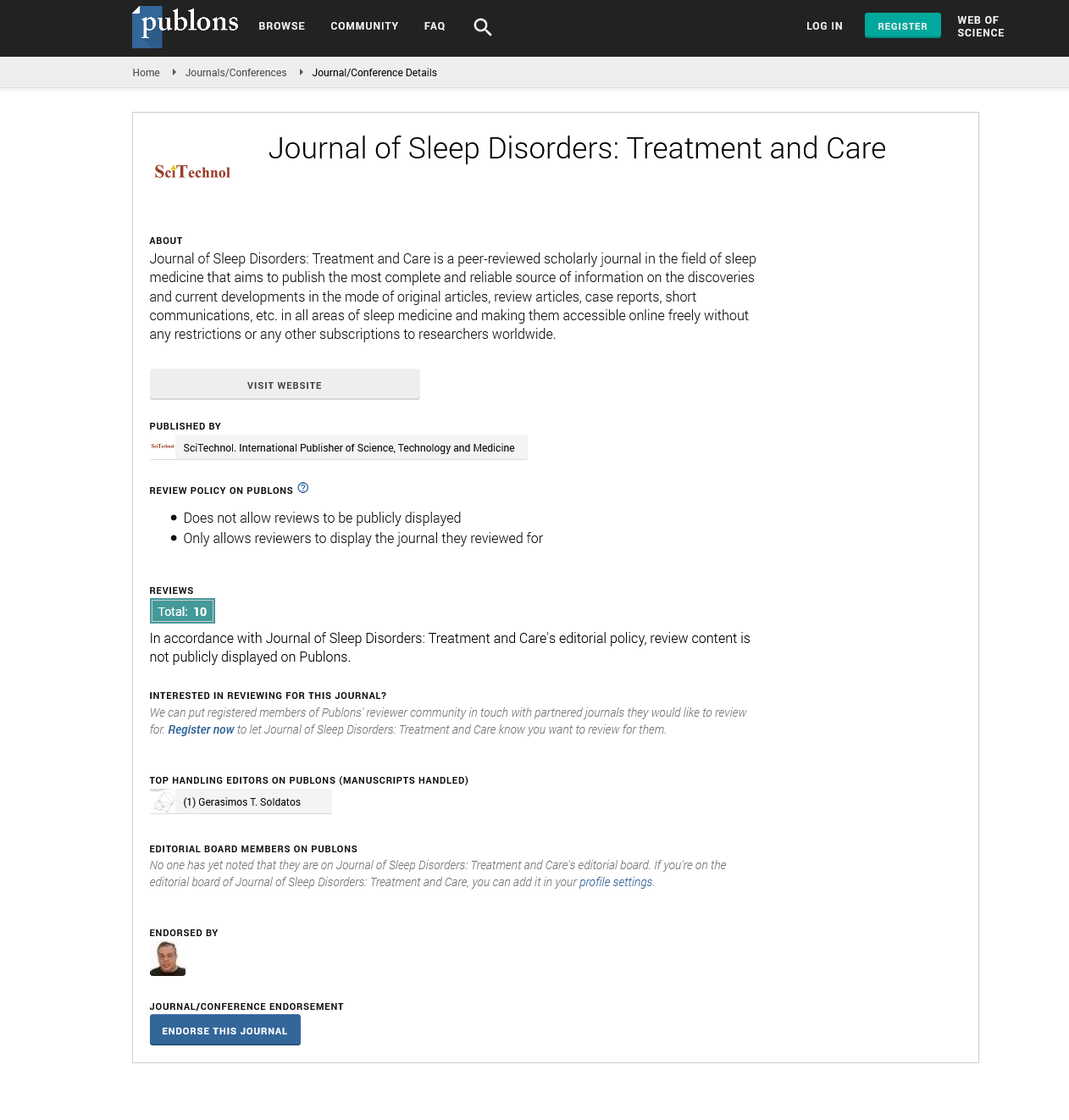Perspective, J Sleep Disor Treat Care Vol: 13 Issue: 1
When Dreams Get Loud: The Science and Solutions for Snoring
Catherina Kate*
1Department of Neurology, Cedars Sinai Medical Centre, University of California, Los Angeles, United States of America
*Corresponding Author: Catherina Kate,
Department of Neurology, Cedars Sinai
Medical Centre, University of California, Los Angeles, United States of America
E-mail: kate172@gmail.com
Received date: 17 September, 2024, Manuscript No. JSDTC-24-148339;
Editor assigned date: 19 September, 2024, PreQC No. JSDTC-24-148339 (PQ);
Reviewed date: 03 October, 2024, QC No. JSDTC-24-148339;
Revised date: 10 October, 2024, Manuscript No. JSDTC-24-148339 (R);
Published date: 16 October, 2024, DOI: 10.4172/2325-9639.1000163.
Citation: Catherina K (2024) When Dreams Get Loud: The Science and Solutions for Snoring. J Sleep Disor Treat Care 13:1.
Abstract
Description
Snoring is a common sleep phenomenon that affects millions of people worldwide. While it is often perceived as a mere annoyance, snoring can have significant implications for both the snorer and their partner. Understanding the science behind snoring and exploring effective solutions can help lessen its impact and improve overall sleep quality. Snoring occurs when the airflow through the mouth and nose is partially obstructed during sleep, causing the tissues in the throat to vibrate. This vibration produces the characteristic sound of snoring. The obstruction can be caused by various factors, including nasal congestion, enlarged tonsils or adenoids, obesity and relaxed throat muscles.
The primary physiological mechanism behind snoring is the narrowing of the airway. During sleep, the muscles in the throat and tongue relax, which can lead to partial collapse of the airway. This narrowing of the airway causes turbulent airflow, resulting in the vibration of the soft tissues in the throat. Factors such as the position of the body during sleep and the anatomy of the throat can amplify this narrowing, leading to louder and more frequent snoring. Certain lifestyle factors and medical conditions can also contribute to snoring. Obesity is a significant risk factor, as excess fat around the neck can increase pressure on the airway, leading to more pronounced snoring. Smoking and alcohol consumption can further relax the throat muscles and increase the likelihood of snoring. Additionally, conditions such as sleep apnea, a serious sleep disorder characterized by repeated interruptions in breathing, can manifest as loud and frequent snoring.
Addressing snoring effectively involves a combination of lifestyle changes and medical interventions. For many individuals, making adjustments to daily habits can significantly reduce snoring. Maintaining a healthy weight through diet and exercise can alleviate the pressure on the airway. Avoiding alcohol and sedatives, particularly before bedtime, can help prevent excessive muscle relaxation. Additionally, quitting smoking can improve overall respiratory health and reduce snoring. Positional therapy is another approach to managing snoring. Snoring is often worse when sleeping on the back, as this position can cause the tongue and soft tissues to collapse into the airway. Sleeping on the side can alleviate this issue and reduce snoring. Special pillows and positional devices are available to help maintain a side-sleeping position throughout the night.
For individuals with persistent or severe snoring, medical interventions may be necessary. Continuous Positive Airway Pressure (CPAP) therapy is commonly used to treat sleep apnea and can effectively reduce snoring by keeping the airway open. In some cases, surgical procedures may be recommended to remove or shrink excess tissue in the throat or to correct structural abnormalities that contribute to snoring. In conclusion, snoring is a multifaceted issue that can disrupt sleep and impact quality of life. By understanding the underlying causes and examen both lifestyle modifications and medical treatments, individuals can take proactive steps to address snoring and improve their sleep quality. While snoring is often seen as a minor inconvenience, addressing it can lead to better rest and healthier relationships for both the snorer and their partner.
 Spanish
Spanish  Chinese
Chinese  Russian
Russian  German
German  French
French  Japanese
Japanese  Portuguese
Portuguese  Hindi
Hindi 
